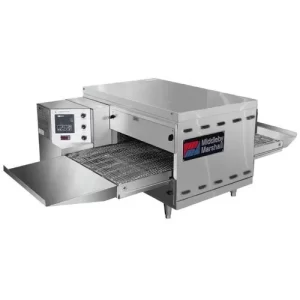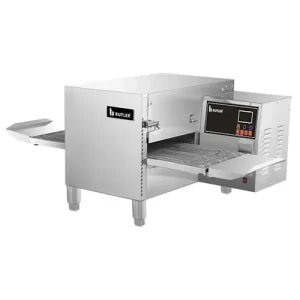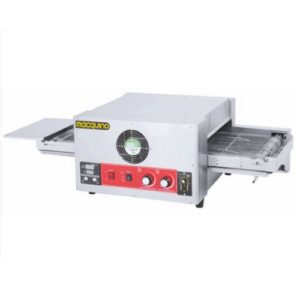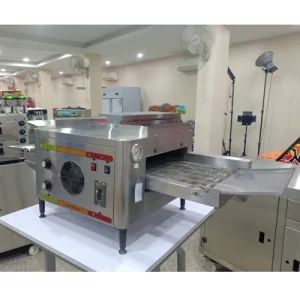Bakery Oven
-
Gas Conveyor Pizza Oven
For Baking Pizza, Bread/Bun, Biscuit/CookiesOperation Type AutomaticPower Source Gas₹505,000.00Gas Conveyor Pizza Oven
₹505,000.00 -
Conveyor Pizza Oven
Air-Flow Direction Vertical Down AirflowMaximum Temperature 300 degreesDisplay DigitalColor SS₹78,000.00Conveyor Pizza Oven
₹78,000.00 -
Electric Conveyor Pizza Oven
Frequency 50-60HZModel Number MQECPO-12Power 6.7KW₹83,000.00Electric Conveyor Pizza Oven
₹83,000.00 -
Electric Large Conveyor Pizza Oven
For Baking PizzaOperation Type AutomaticPower Source ElectricSize Large₹81,600.00Electric Large Conveyor Pizza Oven
₹81,600.00
Bakery Ovens: The Heart of Your Baking Empire
Bakery ovens are the backbone of any successful baking business, whether you’re running a small artisanal bakery or a large-scale commercial operation. These specialized ovens are designed to provide consistent, high-quality results while ensuring efficiency and ease of use. In this comprehensive guide, we’ll explore the world of bakery ovens, their features, and how they can help you take your baking to the next level.
Understanding Bakery Ovens
Bakery ovens are specifically engineered to meet the unique demands of baking. They are designed to provide precise temperature control, even heat distribution, and efficient heat retention, ensuring that your baked goods come out perfectly every time. These ovens come in a variety of sizes, styles, and fuel types to suit the needs of different bakeries.
Types of Bakery Ovens
- Convection Ovens: Convection ovens use fans to circulate hot air around the baking chamber, resulting in faster and more even cooking. They are ideal for baking large batches of cookies, pastries, and breads.
- Deck Ovens: Deck ovens feature individual baking chambers, allowing you to bake different products simultaneously. They are popular among artisanal bakeries for their ability to produce high-quality breads and pastries.
- Rotary Rack Ovens: Rotary rack ovens are designed for high-volume baking. They feature a rotating rack that holds multiple baking sheets, allowing you to bake large quantities of products at once.
- Conveyorized Ovens: Conveyorized ovens use a continuous belt to move products through the baking chamber. They are ideal for high-speed production of items like pizza crusts, crackers, and cookies.
- Wood-Fired Ovens: Wood-fired ovens are a traditional choice for baking artisanal breads and pizzas. They use wood as their fuel source, imparting a unique flavor and texture to the baked goods.
Key Features of Bakery Ovens
- Temperature Control: Precise temperature control is essential for consistent baking results. Look for ovens with advanced temperature control systems that allow you to set and maintain the desired temperature.
- Steam Injection: Steam injection is a feature that injects steam into the baking chamber, creating a moist environment that is ideal for baking breads and pastries with a crisp crust and tender interior.
- Baking Stones: Baking stones are a popular feature in deck ovens. They provide a stable, heat-retaining surface that helps to create a crisp crust on breads and pizzas.
- Oven Lighting: Good oven lighting is essential for monitoring the baking process. Look for ovens with bright, energy-efficient lighting that illuminates the entire baking chamber.
- Ease of Use: Bakery ovens should be easy to operate and maintain. Look for ovens with user-friendly controls, easy-to-clean surfaces, and accessible components for maintenance.
Benefits of Investing in a Quality Bakery Oven
- Consistent Baking Results: A quality bakery oven will provide consistent baking results, ensuring that your products come out perfectly every time.
- Increased Efficiency: Bakery ovens are designed to be energy-efficient and easy to use, saving you time and money in the long run.
- Improved Product Quality: The right bakery oven can help you create high-quality baked goods that stand out in the market.
- Increased Productivity: With features like rotary racks and conveyorized belts, bakery ovens can help you increase your production capacity and meet the demands of your customers.
- Versatility: Many bakery ovens are designed to be versatile, allowing you to bake a wide range of products, from breads and pastries to pizzas and cookies.
Choosing the Right Bakery Oven
When choosing a bakery oven, it’s important to consider your specific needs and requirements. factors to consider include:
- Production Volume: Determine the volume of products you need to bake and choose an oven with the appropriate capacity.
- Available Space: Measure your available space and choose an oven that fits comfortably in your bakery.
- Fuel Type: Consider the fuel type that works best for your bakery, whether it’s gas, electric, or wood-fired.
- Budget: Set a realistic budget and choose an oven that fits within your financial constraints.
- Manufacturer Reputation: Choose a reputable manufacturer with a track record of producing high-quality, reliable ovens.
Maintaining Your Bakery Oven
To ensure that your bakery oven continues to perform at its best, it’s important to maintain it regularly. This includes:
- Cleaning: Clean the oven regularly to remove any built-up grease, flour, or debris.
- Calibration: Calibrate the oven’s temperature control system to ensure accurate readings.
- Preventive Maintenance: Schedule regular preventive maintenance checks to identify and address any potential issues before they become major problems.
- Replacement Parts: Use only genuine replacement parts from the manufacturer to ensure optimal performance and safety.
- Training: Train your staff on proper oven operation and maintenance to ensure that it is used safely and efficiently.
Conclusion
Bakery ovens are an essential investment for any baking business looking to succeed in today’s competitive market. By choosing the right oven and maintaining it properly, you can ensure consistent, high-quality baking results and increase your productivity and profitability. Whether you’re a small artisanal bakery or a large-scale commercial operation, there’s a bakery oven out there that’s perfect for your needs.
FAQ
-
- What types of bakery ovens are available?
- Convection ovens
- Deck ovens
- Rotary rack ovens
- Conveyorized ovens
- Wood-fired ovens
- What are the key features to look for in a bakery oven?
- Temperature control
- Steam injection
- Baking stones
- Oven lighting
- Ease of use
- What are the benefits of investing in a quality bakery oven?
- Consistent baking results
- Increased efficiency
- Improved product quality
- Increased productivity
- Versatility
- How do I choose the right bakery oven for my business?
- Consider your production volume
- Measure your available space
- Choose the appropriate fuel type
- Set a realistic budget
- Choose a reputable manufacturer
- How do I maintain my bakery oven?
- Clean the oven regularly
- Calibrate the temperature control system
- Schedule regular preventive maintenance checks
- Use genuine replacement parts
- Train your staff on proper oven operation and maintenance
- What types of products can I bake in a bakery oven?
- Breads and pastries
- Cookies and crackers
- Pizza crusts
- Pies and tarts
- Cakes and cupcakes
- How do I ensure consistent baking results with my bakery oven?
- Use high-quality ingredients
- Follow recipes precisely
- Monitor the baking process closely
- Adjust temperature and baking time as needed
- Allow baked goods to cool completely before serving or packaging
- What safety precautions should I take when using a bakery oven?
- Wear heat-resistant gloves when handling hot items
- Keep the oven door closed during operation
- Avoid placing flammable materials near the oven
- Keep the oven clean and free of debris
- Train staff on proper oven safety procedures
- How do I troubleshoot common issues with my bakery oven?
- Check the temperature control system for accuracy
- Inspect the oven door seal for any gaps or cracks
- Clean the oven thoroughly to remove any built-up debris
- Check the oven’s electrical or gas connections for any issues
- Consult the manufacturer’s troubleshooting guide for specific issues
- What is the average lifespan of a bakery oven?
- With proper maintenance and care, a quality bakery oven can last for many years. However, the exact lifespan will depend on factors such as usage frequency, maintenance schedule, and environmental conditions.
- What types of bakery ovens are available?




